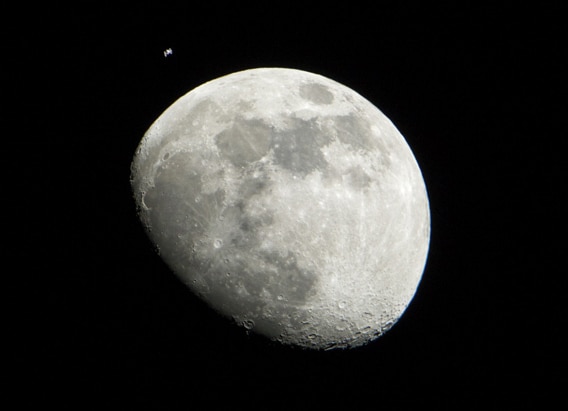Create a free profile to get unlimited access to exclusive videos, sweepstakes, and more!
Two of Earth’s Moons in One Picture

Photographer Lauren Hartnett took a fantastic picture: Two Moons literally passing in the night!
Hartnett was in Houston, Texasâat NASAâs Johnson Space Center, appropriately enoughâon Jan. 4, 2012 when she snapped this. It shows the Moon, just a few days past half full, with the International Space Station sailing past it to the upper left. The station is in low-Earth orbit, so it's much closer than the Moon; it's just a little perspective and orbital mechanics that made them look so close together.
Most people arenât aware the ISS is easily visible to the naked eye when it passes overhead. In fact, if the geometry is right it can outshine Venus and be the third brightest object in the sky (after the Sun and Moon). Iâve seen it many, many times myself, and a few times Iâve also seen incredibly bright flashes of light off the solar panels as they catch the Sun just right. Itâs amazing.
What fascinates me about this picture are the relative sizes of the two moons. I can do some math with this!
The Moon was about 404,000 kilometers (250,000 miles) away when this picture was taken, and is about 3470 km (2170 miles) in diameter.
The ISS orbits the Earth at a height of 400 km (250 miles). Thatâs how far away it would be if it passed straight overhead, but for Hartnett it was at a 30° angle from the zenith (given the Moon's altitude above the horizon at the time). If you remember your trig, that multiplies the distance by a factor of 1.15 (the distance roughly scales as the secant of the angle away from the zenith, if youâre playing along at home), so the ISS was actually about 460 km (290 miles) away at the moment this shot was snapped.
The ISS is about 110 meters across. So letâs see. That makes the Moon about 31,500 times wider physically than the ISS, but 880 times farther away. That means it should be 31,500 / 880 = 36 times the size of the ISS in the picture. I measured it on my screen, and that's almost exactly the ratio I got.
That's so cool. Math!
And of course, it took some pretty sophisticated math to predict the location of the ISS at that time. Happily, if you want to see it, you donât have to crunch the numbers: There are lots of websites thatâll just tell you. I use Heavens Above the most, but others can be found with a flick of your Googling wrist. Give it a try! Seeing the space station is amazing. And just think: There are people up there, living on board. And one, Commander Chris Hadfield, takes lots of pictures from orbit and puts them on Twitter.
So maybe, the next time you see the ISS and try to get a picture, someone up there is snapping one of you, too.
Tip oâ the lens cap to astronaut Ron Garan on Twitter.














